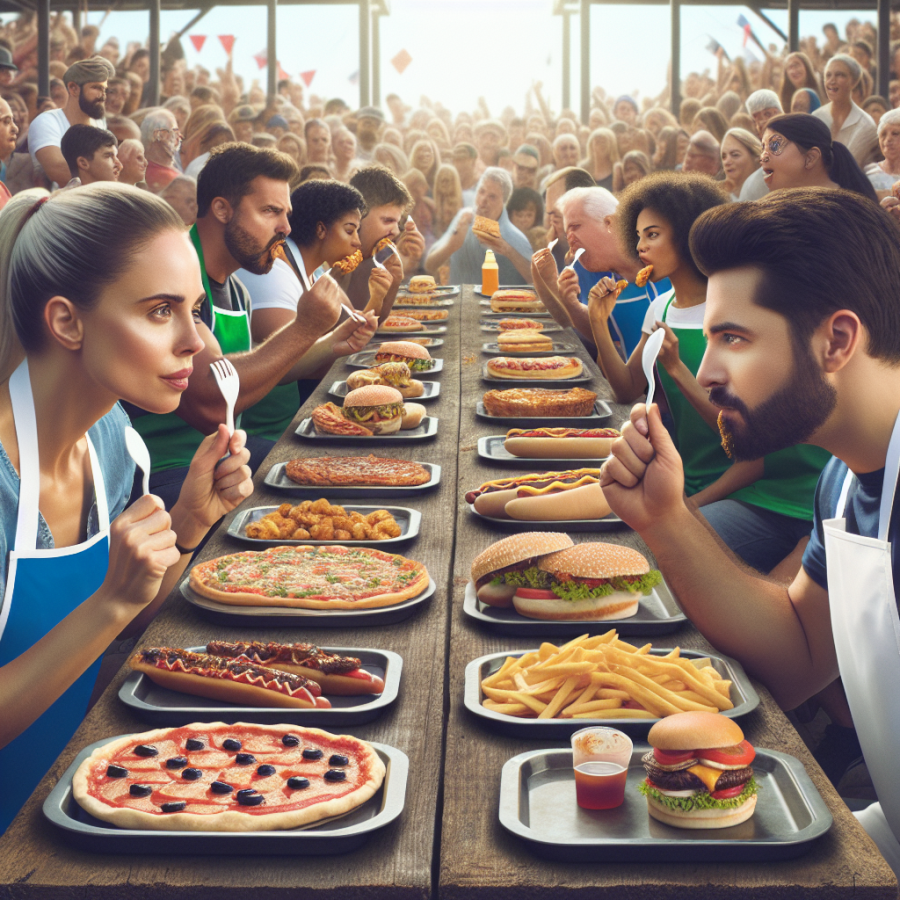The Physical and Mental Game: Preparing for the Extreme Demands of Eating Contests
Competitive eating is not merely about who can eat the most hot dogs in ten minutes or who can keep down a gallon of milk the longest. It's an intense battle that requires a combination of physical capacity, mental fortitude, and strategic expertise. To prepare for the extreme demands of eating contests, serious competitors must train both their bodies and minds.
Physically, one of the most crucial aspects to train is the stomach's capacity. This is often done through various methods including water training, where competitors drink large amounts of water in a short time to stretch the stomach, and food training, which involves consuming large volumes of low-calorie, high-bulk foods like watermelon or oatmeal. Some attempt more extreme methods like chewing large amounts of gum to strengthen jaw muscles or altering their diet in ways that might promote stomach elasticity.
Cardiovascular fitness is surprisingly significant in the sphere of competitive eating. A healthy cardiovascular system improves the body's ability to process and metabolize the massive influx of calories consumed during a contest. Regular exercises, such as running or cycling, help competitors maintain general health, which is strained by the high-caloric intake and can expedite the recovery process after an event.
However, the mental facet is just as crucial as the physical. Competitive eaters must cultivate an exceptional degree of mental endurance. Many practice meditation or visualization techniques to maintain focus during an event. This mental rehearsal can help eaters push through the discomfort and stress of a competition, adhering to their eating strategies even when under immense pressure.
The skill of pacing is also foundational; eaters must learn the optimal speed at which to consume food, a pace that is sustainable and allows for the maximum amount of food to be eaten without necessitating a premature end to their attempt due to being too full or experiencing a reversal of fortune (a polite term for vomiting, which results in disqualification).
Strategically, eaters must also familiarize themselves with the food they'll be consuming. Texture, temperature, and taste all play a role in how quickly and efficiently an eater can consume the contest food. Competitors will practice with the specific food items before the event to find techniques that will give them an edge. This might include finding the best way to break down the food (like dunking buns in water to make them easier to swallow) or figuring out the right chewing technique.
Finally, to deal with the post-competition aftermath, competitors need strategies for recovery.
Read also:
Aiming High: The Thrill of Paralympic Pistol Shooting
Beyond the Plate: Uncovering the Strategies of Competitive Eating Champions
Within the realm of competitive eating, the strategies employed by champions go well beyond the capacity of their stomachs; these competitors are athletes not only in appetite but in technique as well. To understand the intricate details of their success, one must dive into the preparation, mental fortitude, and physical strategies that these gurgitators—yes, that’s an industry term—utilize to conquer extreme eating challenges.
**Physical Preparation and Training:** The hallmark of a competitive eater's strategy is the rigorous and somewhat counterintuitive physical training regimen. To expand their stomachs, eaters regularly practice with large volumes of low-calorie, high-water content foods like watermelon or lettuce. Some embark on jaw-strengthening exercises, chewing numerous pieces of gum to build the stamina required to incessantly chew during a competition. Water training, wherein large quantities of water are consumed in a short period to stretch the stomach, is also commonplace, albeit risky if not done properly.
**Diet and Nutrition:** Before competitions, eaters pay close attention to their diet to ensure their bodies are in peak condition. While it may seem paradoxical, many competitive eaters maintain a relatively balanced diet when they’re not competing, often high in protein and fiber to facilitate digestion and recovery. As a competition approaches, the shift turns to fasting or consuming lighter meals to ensure maximum capacity during the event.
**Technique and Speed Training:** Each competitive eater may have their own signature style, but all focus on techniques that allow them to consume food as quickly as possible. The 'Solomon Technique', for instance, involves breaking food items like hot dogs in half before eating them. Others employ the 'Chipmunking' technique, where they stuff their cheeks with food towards the end of a competition, making sure to swallow it all before time runs out.
**Mental Conditioning:** The psychological component is as critical as the physical. Successful competitive eaters often visualize their victory and practice staying calm and focused under pressure. Some use meditation or breathing techniques to control their body’s natural response to the stress of rapidly ingesting enormous quantities of food.
**Adaptive Strategies:** Adaptive strategies are essential, too, as eaters must be able to both plan their approach and pivot according to the food item they face. Different foods require different strategies. For instance, crunchy items may need to be soaked in water to soften them, while meats may require a specific chewing rhythm.




